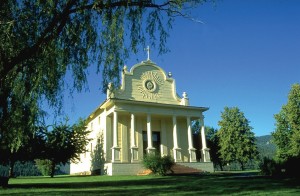
Mission of the Sacred Heart Cataldo Idaho
Indians Gain New Name
For thousands of years nations of tribal people lived in family bands along the lakes and rivers of northern Idaho. The Kootenai Indians lived to the north, near what is now the U.S./Canadian border. The Nimipu lived further south around the confluence of the Snake and Clearwater Rivers. The Schee-Chu-Umsh occupied much of the land between the Kootenai and Nimipu. In the early 1800s French speaking fur traders gave French names to some of the Tribes. The Schee-Chu-Umsh was given the name Coeur d’Alene, which was an attempt to describe their sharp trading practices. They were said to have hearts (Coeur) as sharp as the point of an awl (Alene). The Nimipu became Nez Perce ‘pierced nose’ and a small tribe living near the Kootenai became known as the Pend Oreille ‘ear pendent’.
During the fur trade era, tribal people were introduced to many western goods and ideas, including Christianity. The idea of men wearing black robes delivering a great prayer from a book was so appealing that a neighboring Tribe in western Montana sent a delegation to St. Louis several times looking for a priest. Father Jean DeSmet responded by establishing Saint Mary’s Mission in 1841. When news about the mission reached the Coeur d’Alene Tribe they were convinced that an old tribal legend about men wearing black robes bringing them a great spiritual truth was true.
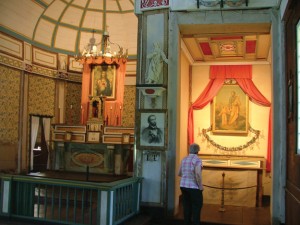
Mission of the Sacred Heart Cataldo Idaho
In 1842 Father DeSmet came to the Coeur d’Alene Tribe and established the Mission of The Sacred Heart. A small log structure was built on the St. Joe River, but due to flooding was moved to a high knoll overlooking the Coeur d’Alene River where a large church was completed in 1853. Designed in a Greco-Roman style by Father Anthony Ravalli, the new church was built from local timbers, including six large Doric columns at the entrance of the building. Cutting, dressing and carving the timbers were done by the Jesuit priests and members of the tribe using simple hand tools.
The Mission of The Sacred Heart, Idaho’s oldest standing building, became a state park in 1975. The Visitor Center at the Old Mission State Park is the permanent home of Sacred Encounters, an exhibition telling the story of the “Blackrobes” and the Coeur d’Alene Tribe.
A Military Presence
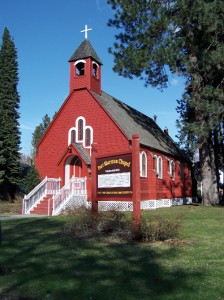
Fort Sherman Chapel
After the Civil War there was growing friction between settlers and native cultures in the west. In 1877, just one year after the defeat of General Custer at the Battle of Little Bighorn, General William Sherman toured the west and recommended to Congress that a new military fort be constructed on the northern shore of Lake Coeur d’Alene. The building of Fort Coeur d’Alene, which started in the spring of 1878, was also the beginning of a small pioneer village that later became the city of Coeur d’Alene. In 1887, the name of the fort was change to Fort Sherman in honor of its founder. The fort was active until 1898 when most of the troops were sent to fight in the Spanish American War. Three of the original fort buildings are still in use on what is now the campus of North Idaho College.
Idaho’s First Road
As the Mission of the Sacred Heat was being completed in 1853, General Isaac Stevens, the first governor of Washington Territory, came through the Northwest with a survey party in search of a northern route for a transcontinental railroad. He assigned Lt. John Mullan with a crew of about 150 men to construct a 624 mile wagon road from Ft. Benton on the Missouri River to Ft. Walla Walla on the Columbia. On July 4, 1861 the men celebrated Independence Day on the crest of a mountain, known today as the Fourth of July Pass, a short distance from the Mission. Mullan’s road was completed in 1862 just as the Civil War got under way.
Rush for Gold & Silver
While Fort Coeur d’Alene was under construction a veteran prospector named Andrew Prichard discovered gold on the North Fork of the Coeur d’Alene River. He and his partners tried to keep the discovery a secret but in the spring of 1883 the word got out. Gold in the Coeur d’Alenes! Thousands of prospectors rushed to the gold fields, including Wyatt Earp and his brothers. The towns of Murray, Prichard and Eagle City sprang up overnight.
In 1884 some of the prospectors began to turn their attention to the South Fork of the Coeur d’Alene. What they found was not gold, but silver. The first silver mines, such as the Tiger and Poorman, were located along Canyon Creek, a tributary of the South Fork. The activity around these mines gave birth to the towns of Burk, Gem and Mace. By 1886 more than a dozen silver mines were in operation along the hills and creeks of the South Fork. The town of Mullan came into existence after the discovery of the Hunter Mine. The township of Kellogg was established in 1892 and named after Noah Kellogg (his jackass is credited with finding the first Galena ore in 1884) founder of The Bunker Hill Mine, known by residents as “Uncle Bunker.” W.R. Wallace, a cousin of Lew Wallace, the author of Ben Hur, built a cabin and a store near the mouth of Canyon Creek and began to make plans for a town. His town of Wallace became the hub of one on the richest mining districts in the world.
Trains, Boats, & People
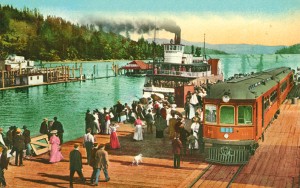
Steamboat on Coeur d’Alene City Dock 1910
The discovery of gold and silver coincided with the completion of the Northern Pacific Railroad, the second transcontinental rail line in the U.S. By 1887 a railroad/steamboat transportation system was constructed to connect the new silver mining district to the main line of the Northern Pacific Railroad. By 1910, most of the towns in northern Idaho were served by at least one of the four major railroads that ran through the area. Beginning in 1905, an electric railroad ran from Spokane to Coeur d’Alene, which made connections to steamboat excursions on Lake Coeur d’Alene.
Spanning 400 feet across Sand Creek in downtown Sandpoint, the Cedar Street Bridge Public Market is the only marketplace on a bridge in the United States. Built in 1906 as an auto and pedestrian bridge, it originally carried traffic from downtown to the train depot on the east bank of Sand Creek. As train travel declined in the following decades the bridge became less integral to transportation needs and fell into disrepair. In the early 1980s Scott Glickenhaus, a local entrepreneur and world traveler, saw an opportunity to create a unique public gathering place. His idea, inspired by the Ponte Vecchio in Italy, was to create a marketplace-on-a-bridge with a distinctive Northwest flair. Opened in 1983, the bridge features a unique passive solar design, multiple support pilings driven into Sand Creek and massive tamarack timbers selectively harvested in Idaho and Montana.
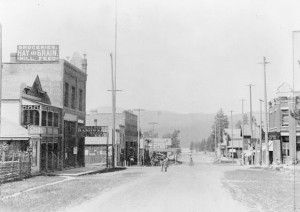
Sherman Ave Coeur d’Alene Idaho 1892
Originally named Westwood, in 1881 Rathdrum was renamed after a town in Ireland in order to obtain its own post office. It was county seat of Kootenai County until 1908. It was the end of the Northern Pacific Railroad route to the Coeur d’Alene Mining district. From here, miners took a stage to Coeur d’Alene and a steamboat to Cataldo. In 1886, a branch line to Hauser re-routed traffic. Several of Rathdrum’s historic buildings reflect its prosperous days as the county seat.
At one time a rough-and-tumble logging town, Harrison still sports remnants of its colorful past. Historic buildings, like the community’s two churches, weathered saloons and even the city’s cemetery, all stand as testament to the hardy souls who built this one-time boom town. In the early 1900s, Harrison was a main port for the big passenger steamers that navigated Lake Coeur d’Alene.
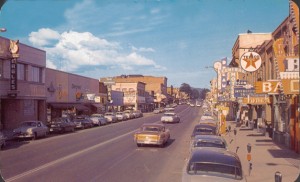
Sherman Ave Coeur d’Alene Idaho 1950
Bonners Ferry was named for Edwin Bonner. He was the builder of the first ferry boat on the Kootenai River that was used for transportation needs of gold prospectors of Wild Horse Creek in British Columbia. The Kootenai River, which flows through Bonners Ferry is a fickle patriot. Originating in Canada, it flows South across the U.S. border then returns North back into Canada eventually emptying into Kootenay Lake.
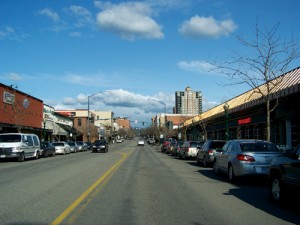
St. Maries developed as a steam-boat stop and major distribution center for raw logs, at the confluence of the St. Maries and St. Joe rivers. It was named by Father Pierre DeSmet, who built the original mission on the St. Joe just north of town. Flooding forced the priest to move the mission to Cataldo, where it stands today as the oldest original building in the state.
Timber Boom
Following a report made by a U.S. Geological Survey in 1898 about the abundant timber resources in the Pacific Northwest, several eastern lumber companies moved into North Idaho and began building their empires. These companies purchased vast amounts of timber lands, built mills, railroads, logging camps, company stores, and even town sites. With the logging boom in full swing by 1910 thousands of people swarmed into northern Idaho as to a gold rush. Coeur d’Alene grew from a small pioneer town of about 500 to a modern city with a population of more than 7,000. Water front towns such as Sandpoint, Harrison, St. Maries, Post Falls, Priest River, Bonners Ferry and Spirit Lake became bustling timber towns.
Frederick Post came upon a falls in the Spokane River in 1871 and visualized the ideal location for a sawmill. He negotiated a treaty with Chief Andrew Seltice of the Coeur d’Alene Tribe and started the area’s first commercial sawmill in 1880. The settlement of Post Falls grew up around the mill. The dam is now operated by Avista Utilities and is the site of Falls Park, with observation decks open to the public. The Coeur d’Alenes and much of northern Idaho had immense stands of white pine and met all the conditions for logging, including transcontinental railroads to take the lumber to market. Many of the towns in northern Idaho began as logging centers.
North Idaho Waters
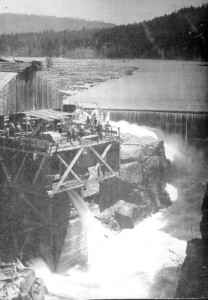
First lumber mill at Post Falls Idaho
Prior to 1846, Native Americans inhabited the shores of Hayden Lake. Legend has it that in 1878 a pioneer named Matt Heyden and another early homesteader, John Hager got into a poker game to see who would name the lake. Heyden won, although time altered the spelling to Hayden Lake. The Hayden Lake Country Club was once a recreational stop on the areas electric railroad known as The Bozanta Tavern, one of the finest resorts in the Northwest. It is also the site of the first 18-hole golf course in Idaho.
The village of Bayview was the terminus for lake steamers bringing lumber and lime from other points on the lake. After the start of World War II, Farragut Naval Training Center was built just west of Bayview. The second largest training center in the country, it processed 293,381 sailors in one 15-month period. After the war the center was decommissioned and given to the state of Idaho for a state park.
Priest Lake is named from the legend of a priest, ministering to early settlers, who disappeared one winter and was presumed drowned in the cold, clear waters. The lake is also famed for being the site of several early silent movies produced by Nell Shipman in the 1920s.
The city of Sandpoint is named for the extensive sandy beach area that extends into Lake Pend Oreille near downtown. Lake Pend Oreille (pronounced Pond-O-ray) is said to have been named by French fur trappers who thought the lake was shaped like a large ear. The lake is over 43 miles long, six miles wide and its depth is more than 1,200 feet. Early trapper, David Thompson who worked for The Hudson Bay Company, charted maps for much of North Idaho. In 1809 he built a trading post east of Sandpoint near Hope, called the Kullyspel (Kalispel) House which is Idaho’s first structure built by a non-native.
Top Ten Historic Sites in Northern Idaho
(Random Order)
- Mission of the Sacred Heart, Idaho’s oldest standing building – Cataldo
- The goldmining town of Murray
- The city of Historic Wallace
- Old Kootenai County jail – Rathdrum
- Marble Creek Interpretative Site – East of St. Maries
- Remains of Fort Sherman – Coeur d’Alene on N.I. College Campus
- Hanna Flat Cedar Grove – Priest Lake
- The Vinther-Nelson Cabin/Museum – at Priest Lake’s Eight Mile Island
- Treaty Rock inscription and petroglyphs – Post Falls
- 4th of July Mullan Trail Center – 4th of July Pass